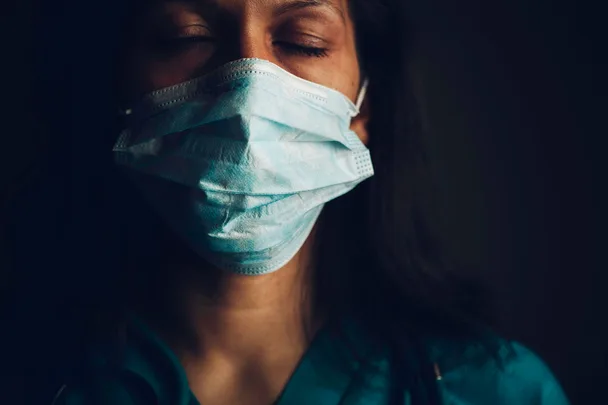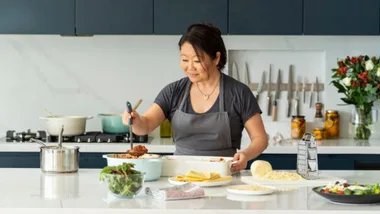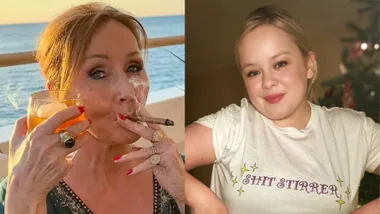On the first of June 2018, plastic surgery registrar Dr Yumiko Kadota was driving to Bankstown-Lidcombe Hospital in western Sydney, where she had been spending nearly every waking hour – and many fitfully sleeping ones – since February. It wasn’t unusual for her to be working 120 to 140 hours a fortnight at the hospital, and when she wasn’t, she was on call, sometimes for eight days in a row, with phone calls waking her up at all hours of the night.
Thirty-year-old Kadota was not the sort of person to take her foot off the gas. She loved the challenge of complicated surgery with its unique nexus of creativity and skill, and the satisfaction of knowing the positive difference it could make to a patient’s life when it was done well. This was a woman who placed third in her anatomy class at the University of New South Wales and ran marathons in her spare time. Toughness and resilience came naturally to her. But not even Wonder Woman – a nickname Kadota had among her friends – could keep going like this. She knew she wasn’t coping. The exhaustion was suffocating. She was dehydrated and undernourished from eating nothing but hot chips or banana bread at the hospital canteen in those rare moments when she could spare a minute to put something into her body.
She was terrified she’d make a mistake that could harm one of her patients or, worse, cost them their life. Even the snatches of rest she managed to get at the hospital when it was too late to drive home – often slumped in a chair in the recovery ward – were punctuated by the beeping of machines, pagers and the voices of other medical staff. Any efforts she made to draw attention to her increasingly untenable situation fell on deaf ears. After questioning why she’d been woken to take a non-urgent call at 3am, Kadota was taunted by a superior who said she was just being an “emotional female”. Even when she presented a letter from her GP stating that her health was in jeopardy, it had no impact on her punishing roster.
One night, after spending four hours at the end of a 20-hour shift reattaching a man’s fingers severed by a chef’s knife – a task that should’ve been supervised by a senior surgeon but wasn’t – she asked for a short break. It was refused. “I remember doing those sorts of hours when I was at your stage,” a superior told her. “It’s good for you.”
But Kadota knew it wasn’t. As she drove back to the hospital on that first day of June to begin her 24th straight day of work, she suddenly, horrifyingly, evacuated her bowels, right there in her car. “I lost continence,” she says. “I’d been able to ignore all the mental signs that something was wrong. But once your body breaks down like that, it’s a huge warning sign.”
It was the final straw. She quit that day, just hours before crashing her car on the way home. Mercifully, she survived, but four months later, she was hospitalised for six weeks suffering from depression and insomnia. “I’m good now,” Kadota, who practises yoga daily and teaches anatomy at her alma mater, the University of NSW, tells marie claire. “But it took me two long years to fully recover. I’d be a fool to ever go back to that again.”

The medical profession in Australia is losing talented, dedicated doctors such as Kadota at rates that should make all of us fearful for its future. Bullying, overwork, the pressure of the job, discrimination and “old-boys’ club” attitudes have all been cited as reasons many young doctors give up their dreams of healing the sick and saving lives. A recently updated Beyond Blue report into doctors’ mental health found doctors generally had far higher rates of depression and suicidal ideations than the broader population, and that young female doctors were the most vulnerable of all. Eight per cent of female doctors reported they had been diagnosed with a psychiatric disorder compared to five per cent of their male counterparts, and 3.3 per cent even said they had attempted suicide in the previous 12 months, compared to 1.6 per cent of males. Critically, doctors and doctors in training seem less inclined to seek help if they sense their mental health is deteriorating.
“It can be very survival-of-the-fittest,” explains Kadota, who has since written a book, Emotional Female, outlining her experience and the issues facing the industry. “It’s very competitive, and if you show any signs of weakness, you worry it might affect your chances of getting selected into training programs.”
Women face unique challenges when trying to succeed in what is already a punishing pathway to becoming a doctor, and it begins in their years as trainees. Reports of sexism, exploitation and sexual harassment are so prevalent, and the career risks of speaking up are so great, that in 2015 Dr Gabrielle McMullin, a Sydney vascular surgeon and contributing author to Pathways to Gender Equality, told a shocked audience that any woman who wanted to secure her medical career would probably be better off complying with unwanted sexual advances. Those who speak up, she said bluntly, can expect to have their careers stalled indefinitely. “Of course, I don’t condone any form of sexual harassment … but unfortunately that is the truth at the moment – that women do not get supported if they make a complaint,” she said later. “And that’s where the problem is. What I’m suggesting is that we need a solution for that problem, not to condone that behaviour.”
A large part of the problem is that so much of a trainee doctor’s chances of selection into courses and specialities are dependent on references from superiors. “People think that when you finish medical school you have job security, but every year you have to apply for a job as a junior doctor,” Kadota explains. “You rely on good references to keep progressing. There’s immense pressure to perform well and to pander to your bosses. I think a lot of junior doctors, especially ones who haven’t made it to a training program yet, are vulnerable to exploitation.”

The power imbalance between young female doctors competing for coveted placements in training programs and older, often male doctors being given the discretionary power to grant these advancements is glaringly obvious. Surgery, the area in which Kadota was hoping to forge her career, is known for being particularly male-dominated. Although 50 per cent of medical graduates are female, women make up only 12 per cent of the surgical field.
Sexism is there from the start. During her early years as a junior doctor, Kadota says she was frequently overlooked for learning opportunities from the senior surgeons in favour of the blonder, more conventionally “pretty” trainees. And on the flipside, one particular surgeon would hiss at Kadota to “take your clothes off” in Japanese so no-one else would understand. “You really couldn’t win,” Kadota says. “If you’re not pretty enough, you don’t get chosen. And if you’re too pretty or you dress a certain way, you get sexually harassed. You have to find this middle ground where you stand out enough to be seen as a good doctor but not stand out too much and get attention you don’t want.” The Australian Medical Association says 70 per cent of women physicians claim to have faced gender discrimination in the form of disparaging and disrespectful comments, lack of career promotion and disparities of reimbursement between them and their male counterparts. And non-white women face additional discrimination on top of that.
Dr Melissa Yang, a Melbourne-based respiratory and sleep physician, is one of the founders of Doc to Doc, a peer support group for female doctors set up in 2017 after a number of physicians committed suicide. The hurdles for women in medicine, she says, carry through as she climbs the ladder. “Women are constantly passed over for advancement or for specialist courses because it’s assumed that they’ll be taken out because of family and parental responsibilities,” she says. “I have friends who had a baby after their first year of specialist training and took six months or a year out. After they had their babies they were told they couldn’t come back to their specialist area. They were just told no, with no reason or explanation given. The path of least resistance for them was just to change specialities.”

Hospitals and colleges aren’t unaware of the untenable pressures faced by aspiring doctors. In early 2019, several colleges banned trainee doctors from working in some hospitals, due to concerns over unsafe working conditions. The College of Intensive Care Medicine (CICM) barred several of its trainees from working in the Intensive Care Unit at Sydney’s St George Hospital amid claims of bullying and dysfunction. (The hospital’s then-general manager, Dr Leisa Rathborne, confirmed the loss off accreditation was “due to cultural issues within the unit”, and that management was working with ICU staff and CICM to resolve the matter.) Similar hardline actions were taken against various departments at Tamworth, Royal Prince Alfred and Westmead hospitals in Sydney.
In addition, various hospitals, colleges and professional bodies have implemented training programs and initiatives to address issues such as bullying, inequality and overwork. “We were appalled with what happened to her at Bankstown,” Dr Sanjay Hettige, co-chair of the Australian Medical Association (NSW) Doctors in Training Committee, told marie claire when he first read Kadota’s blog post in 2018. In response, the AMA put together a set of recommendations that would give unaccredited registrars in particular – trainee doctors who aren’t affiliated with a medical college or council – clearer guidelines around what’s expected in their roles. The recommendations are currently with the health minister waiting for a green light.
But both Kadota and Yang are wary of seeing any on-paper policies as a silver bullet. Kadota remembers 2017 as a particularly horrifying year for young doctors, punctuated by a spate of deaths by suicide, including that of 29-year-old Sydney doctor in training Dr Chloe Abbott, who, her sister Micaela said later, was “eaten alive” by the punishing demands of her hospital schedule and her fear of speaking up about it. At the time, the media attention around Abbott’s death led to many promises from the peak bodies, colleges and hospitals that more focus would be directed towards junior doctors’ welfare. “Oh, there’s lots of initiatives, lots of policies. But most of them feel like lip service to make the colleges look like they’re doing something,” Kadota says. “I’m yet to be convinced about the effectiveness of these shiny new campaigns.” Yang points to mentorship programs set up around Australia at various colleges and hospitals as a good idea in theory, but rarely useful in practice. “Half the time, it’s little more than a form and you tick a box and not much happens beyond that,” she says.

Systemic change is always a hard slog when those who hold the power don’t believe anything’s amiss. Kadota says she regularly came up against “survivorship bias” during her time in hospitals, a phenomenon where older, established doctors would make it clear that if they could make it through medical training, then others should be able to as well. Of course, one person’s personal experience conveniently overlooks all those others who dropped out and were never heard from again, despite the fact they could have made great doctors.
Anonymous online comments in discussions of doctor burnout often snipe that today’s doctors are “too thin-skinned”, spoilt gen Ys who need to toughen up, and that female doctors in particular are too frail, too emotional, too likely to run off and have babies, to be of much use. In late 2019, Professor Hans Peter Dietz, a senior Sydney obstetrician and member of the state council of the NSW medical union, wrote an email to colleagues bemoaning what he saw as the downsides to the “increasingly female” and therefore “vulnerable” workforce. “Suicides are one result. Inability to cope with everyday nastiness is another,” he wrote. “Women colleagues are more likely to drop out … fall ill, which is why it’s harder to staff departments these days. They’re more expensive to train in the sense that their lifetime work years will be less.”
Kadota rejects the premise that young doctors of either gender lack stamina or toughness. “Doctors are resilient people,” she insists. “Even in the early stages of our training we deal with death and cancer and all kinds of difficult human tragedies from a young age. Giving us resilience training isn’t going to change things. There’s that old analogy of the canary in the coalmine. We keep trying to make stronger canaries. That isn’t the answer.”
Yang thinks there are practical steps hospitals and colleges could take to make workplaces safer and more conducive for success for young female doctors. “I’d like to see gender and racial diversity take much more of a priority, especially on selection boards, deciding who gets in [to training courses] and who doesn’t,” she says. And while medicine doesn’t stick to a schedule, Yang believes some work-life balance is achievable if resources are directed to the right places. “Put more time and resources into mentoring, flexible hours and access to good parental leave programs for both men and women,” she says.
Just as importantly, the conversation about what is and isn’t acceptable behaviour in the profession needs to keep happening. One of Doc to Doc’s most valuable resources, Yang says, is its vibrant Facebook group, where nearly 10,000 female medicos share their experiences, giving each other tips and generally offering a place of support and collaboration.
Kadota was thrilled to learn a blog she wrote in 2018 about her experience is part of the curriculum at UNSW. “Everyone in their final year reads my blog as part of a compulsory module,” she says. “When I went through medical school we never learnt about what to do if you are faced with poor work practices. Perhaps it means my story could help someone. It feels good to think it wasn’t in vain.”
This feature originally appeared in the March issue of marie claire Australia, on stands now.
 Image: Getty Images
Image: Getty Images









